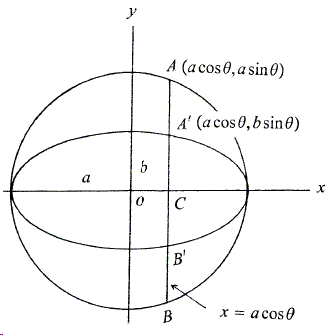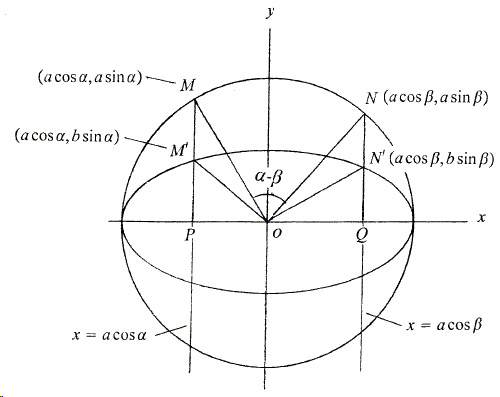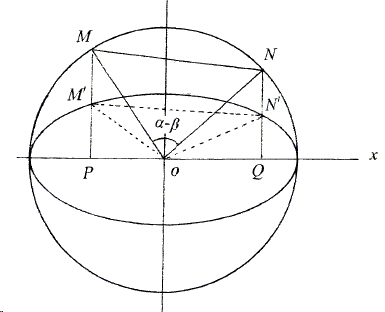Sidney Kung
Area, Sector Area, and Segment Area of an Ellipse

Let \(A_{1}\) and \(A_{2}\) be the areas of a circle and an ellipse, respectively. Line \(x=\mbox{cos}\theta\) intersects the circle at \(A\), \(B\) and the ellipse at \(A',\) and \(B'\), respectively. It's easy to see that \(\frac{A'C}{AC}=\frac{A'B'}{AB}=\frac{b}{a}\). Thus, from (*), the area of the ellipse is
(1)
\(A_{2}=\frac{b}{a}A_{1}=\frac{b}{a}\pi a^{2}=\pi ab\).
An elliptic sector is a region bounded by an arc and line segments connecting the center of the ellipse (the origin in our diagrams) and the endpoints of the arc.

Let lines \(x=a\space\mbox{cos}\alpha\) and \(x=a\space\mbox{cos}\beta\) be perpendicular to the \(x\)-axis, and let \([F]\) indicate the area of figure \(F\).
The coordinates of the points \(M\), \(M'\), \(N\), \(N'\) are \((a\space\mbox{cos}\alpha , a\space\mbox{sin}\alpha)\), \((a\space\mbox{cos}\alpha , b\space\mbox{sin}\alpha)\), \((a\space\mbox{cos}\beta , a\space\mbox{sin}\beta)\), and \((a\space\mbox{cos}\beta , b\space\mbox{sin}\beta)\), respectively. Since \(\frac{N'Q}{NQ}=\frac{M'P}{MP}=\frac{b}{a}\), we have \(\frac{[PM'N'Q]}{[PMNQ]}=\frac{[N'OQ]}{[NOQ]}=\frac{[M'OP\space]}{[MOP\space]}=\frac{b}{a}\). Thus,
\(\frac{[PM'N'Q]-[N'OQ]-[M'OP\space]}{[PMNQ]-[NOQ]-[MOP\space]}=\frac{b}{a}\), or \(\frac{[M'ON']}{[MON\space]}=\frac{b}{a}\).
Therefore, the area of the elliptic sector \(M'ON'\) is
(2)
\([M'ON']=\frac{b}{a}\left(\frac{\alpha -\beta}{2\pi}\right)\pi a^{2}=\frac{1}{2}(\alpha -\beta)ab\). \((\alpha \gt \beta)\).
An elliptic segment is a region bounded by an arc and the chord connecting the arc's endpoints.

Note that the area of the elliptic segment (in then diagram) is equal to the area of sector \(M'ON'\) minus the area of \(\triangle M'ON'\). Hence, the elliptic segment area is
(3)
\(\frac{ab}{2}(\alpha -\beta)-\frac{b}{a}\left(\frac{a^{2}}{2}\mbox{sin}(\alpha -\beta)\right) =\frac{ab}{2}\left((\alpha-\beta)-\mbox{sin}(\alpha-\beta)\right)\).
![]()
- Cavalieri Principle
- A Generalized Cavalieri-Zu Principle
- Area, Sector Area, and Segment Area of an Ellipse
- Volume of a Sphere and Volume of an Ellipsoid
- Volume of an Elliptic Paraboloid
- Volume of a Hyperboloid of One Sheet
- Volume of a Hyperboloid of Two Sheet
- Volume of a Paraboloid of Revolution
![]()
|Contact| |Front page| |Contents| |Geometry|
Copyright © 1996-2018 Alexander Bogomolny73573836
